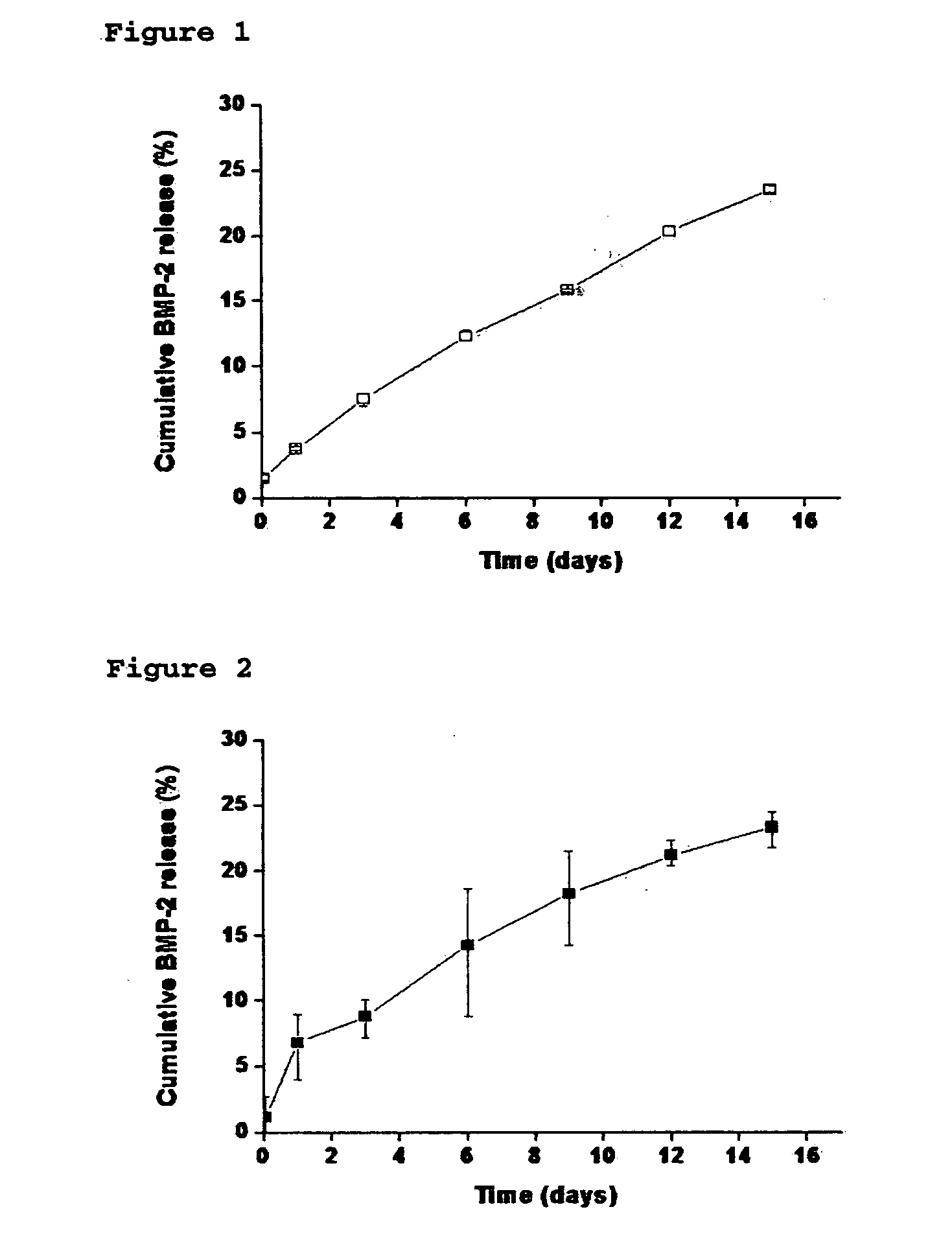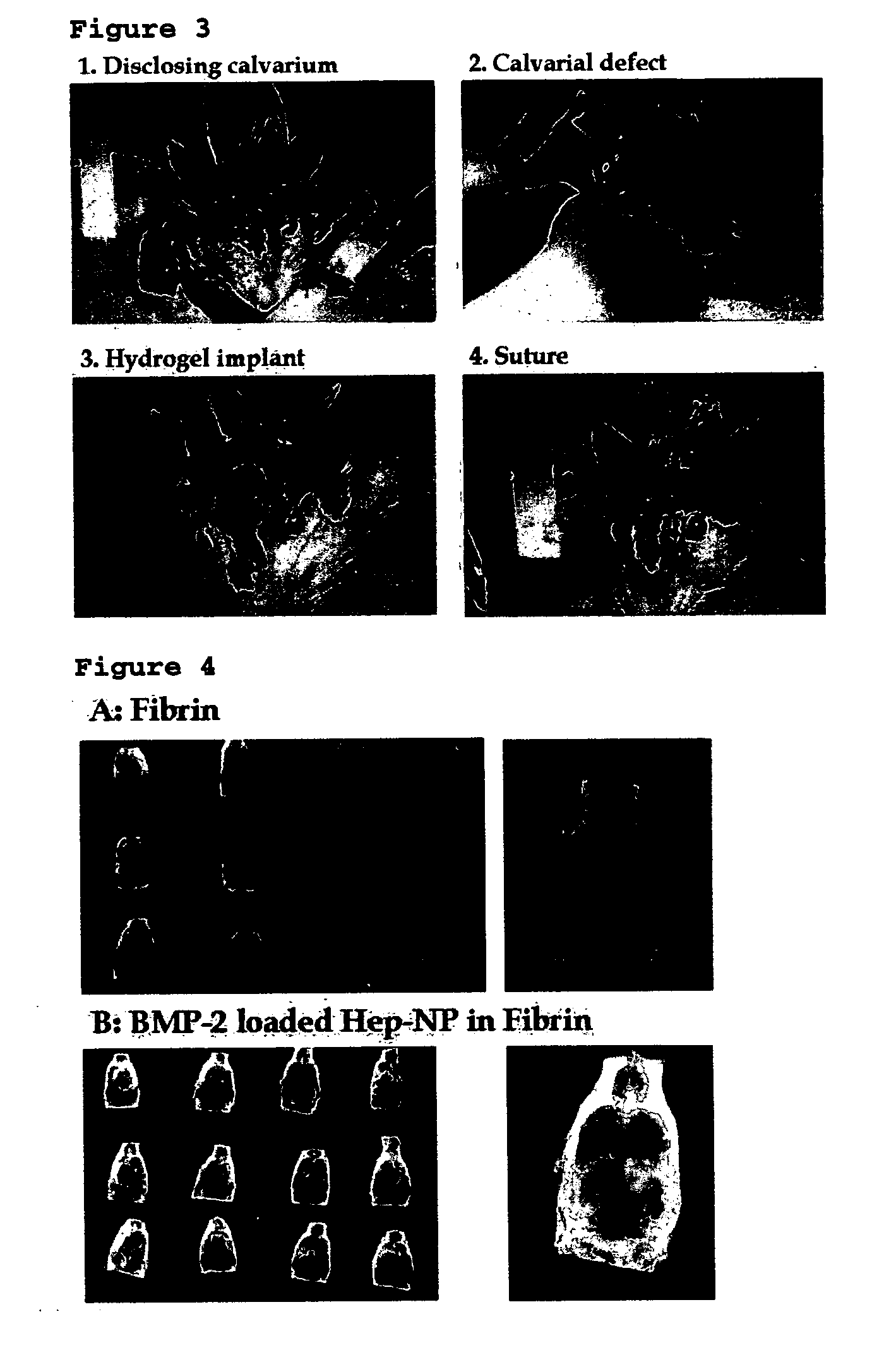Composite comprising polysaccharide-functionalized nanoparticle and hydrogel matrix, a drug delivery system and a bone defect replacement matrix for sustained release comprising the same, and the preparation method thereof
- Summary
- Abstract
- Description
- Claims
- Application Information
AI Technical Summary
Problems solved by technology
Method used
Image
Examples
examples
[0077] The present invention is described more specifically by the following Examples. Examples herein are meant only to illustrate the present invention, but in no way to limit the claimed invention.
[0078] The paper of “Biomaterials 27 (2006) 2621-2626” is incorporated by reference herein in their entirety for better understanding of the gist of the present invention, especially of the experimental process herein.
A. Step 1: Nanoparticles
1. Comparative Preparatory Example
Preparation of Non-Functionalized Nanoparticles with Hydrophilic Hydrogel Layer (PLGA NP)
[0079] 40 mg of PLGA was completely dissolved in 2 mL of dimethylsulfoxide, and this solution was slowly added in 30 mL of 5% aqueous solution of poloxamer, thus providing non-functionalized nanoparticles. Remaining poloxamer and dimethylsulfoxide were removed by performing high-speed centrifugation, followed by separation of supernatant liquid. Thus obtained nanoparticles were resuspended in distilled water or PBS (phosph...
experimental preparatory example
3. Experimental Preparatory Example
Observation of Size, Surface Charge, Contents and Polydispersity of Heparin-Functionalized Nanoparticles (HEP-PLGA NP)
[0081] The size and the surface charge of the prepared nanoparticles were measured according to the dynamic light scattering method and the electrophoretic light scattering method, respectively, by using ELS-8000 (Otsuka Electronics Co., Japan).
[0082] The size increased from 123.1±2.0 nm to 188.1±3.9 and the surface charge varied from −26.0±1.1 mV to −44.4±1.2 mV with the increase of heparin amount in the aqueous solution of poloxamer. As the heparin carries a strong negative charge, the relatively higher negative value in surface charge means that a higher amount of heparin exists on the surface of the nanoparticles.
[0083] Dry weight of the nanoparticles was calculated after freeze-drying the nanoparticles. The partial amount of the heparin in the hydrogel layer and the total amount of the heparin in the nanoparticles were calcu...
experimental preparatory example 2
5. Experimental Preparatory Example 2
In Vitro Observation of Sustained Release and Stabilizing Effect of Lysozyme (Lysozyme-Loaded PLGA NP & Lysozyme-Loaded HEP-PLGA NP)
[0091] In vitro release behavior was observed to ascertain the sustained release of lysozyme and the stability of protein drug by using the systems (i.e. the nanoparticles loaded with drug) prepared in Comparative Preparatory Example and Preparatory Examples 1-2 of Step 2.
[0092] After suspension solution of nanoparticles loaded with lysozyme was placed in a dialysis tube (MWCO 500 k), the released lysozyme was collected by using a large amount of PBS solution under the infinite dilution condition. The amount of the collected lysozyme was quantified according to the Micro BCA protein quantification. PBS used for collecting lysozyme was replaced with new one every day, and the sample was stored at 4° C. until the protein quantification was performed.
[0093] The nanoparticles with no heparin released about two thirds ...
PUM
| Property | Measurement | Unit |
|---|---|---|
| Pressure | aaaaa | aaaaa |
| Mass | aaaaa | aaaaa |
| Mass | aaaaa | aaaaa |
Abstract
Description
Claims
Application Information
 Login to View More
Login to View More - R&D
- Intellectual Property
- Life Sciences
- Materials
- Tech Scout
- Unparalleled Data Quality
- Higher Quality Content
- 60% Fewer Hallucinations
Browse by: Latest US Patents, China's latest patents, Technical Efficacy Thesaurus, Application Domain, Technology Topic, Popular Technical Reports.
© 2025 PatSnap. All rights reserved.Legal|Privacy policy|Modern Slavery Act Transparency Statement|Sitemap|About US| Contact US: help@patsnap.com



